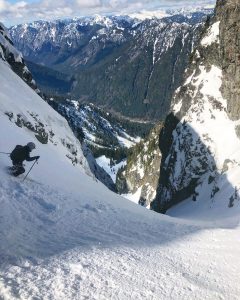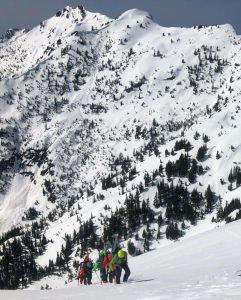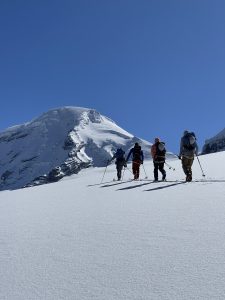2021 Dynafit Scholarship | Patrick Chu
I am certain that there is no better tool suited for the mountains than a pair of skis. Simple in concept and elegant in function, skis allow us to travel efficiently over snow-covered terrain while providing endless opportunities for gravity-fed entertainment.

Hop turns in the classic Slot Couloir. 📷: Ian Nicholson
Skis can transform how we look at the mountains, shifting our focus away from features such as dramatic ridgelines and buttresses to talus fields, cliffs, and couloirs that are both inconspicuous and uninspiring in the drier months. They are an apparatus on which we can discover the freedom to explore, play, and push ourselves in the mountains. For me, skiing is a way of life, and it is a pursuit that I cherish sharing with others.
In early April 2021, I participated in the AMGA Advanced Ski Guide Course and Aspirant Exam in Washington’s North Cascades to continue my professional development as a skier and guide. This 10-day program builds off the Ski Guide Course material and introduces methods and systems for guiding in more complex ski mountaineering terrain. Washington state provides a unique assortment of venues to learn and practice skills ranging from steep skiing techniques (e.g., belayed skiing and rappelling into lines) to glacier travel, crevasse rescue, and whiteout navigation.

Nearing the summit of Red Mountain at Snoqualmie Pass 📷: Patrick Chu
Guide courses such as these depend highly on the collective energy of the instructors and participants to foster a positive and productive learning environment. That means everyone needs to show up fit, technically dialed, and ready to perform at a high level. Our crew was solid and capable, which allowed us to jump into some fantastic terrain at Snoqualmie Pass early on in the program to learn and refine techniques for guiding in steep and technical ski mountaineering terrain.

Matt Park and Michael Gardner completing a successful run through the sled rescue drill. 📷: Patrick Chu
While the program had a strong emphasis on learning and development throughout, at the Aspirant level, there is an examination component where participants must demonstrate proficiency in an emergency sled lower drill and avalanche rescue scenario. These are vital skills for a ski guide’s toolbox when faced with a crisis, such as an injury that renders a skier non-ambulatory in the backcountry, or worse, an avalanche burial. Being tested can be an uncomfortable experience but performing under pressure is an integral part of what we do as guides, and ultimately contributed to a more meaningful learning experience. Each participant successfully demonstrated the required skills and even managed to have a bit of fun doing it.
After several days in the Snoqualmie Pass zone, we headed north towards Mount Baker to concentrate on skiing in glaciated terrain. A stretch of inclement weather and new snow provided an excellent opportunity to practice on-sight ski guiding in poor visibility while managing widespread wind and storm slab hazard. While I’m sure that most of us would have preferred skiing hero snow under sunny skies, the challenging conditions pushed us to work closely as a team and sparked many valuable discussions on tour planning, route finding, and terrain evaluation.

Touring up the Coleman Deming route in stellar conditions 📷: Matt Park
A small weather window towards the end of our course allowed for a single-day climb and ski of Mount Baker via the Coleman-Deming route. It would be our chance to apply many of the skills we had learned throughout the course into a single big objective. Mount Baker, coated in a fresh blanket of new snow, greeted our crew with clear skies, cold temperatures, and light wind. We reached the summit in good time and enjoyed over 7000′ of incredible skiing, most of which was perfect boot-top powder.
As we swapped leads on the descent, I came to appreciate some of the significant challenges of ski guiding in glaciated terrain, like finding the best possible continuous pitches of fall line skiing while simultaneously managing group spacing, avoiding crevasses, and nailing the exit. During our group debrief, it was apparent that the day was an undeniable success and that all of us had taken something valuable away from it. With a large segment of the road up to the Heliotrope trailhead covered in snow, our uphill effort for the day ended up being just shy of 10,000′ vertical— a solid day in the hills.
For those who choose the mountains as their classroom, the best learning comes through firsthand experience in these formidable places, where skill and sense must meld in the face of technical challenges and uncertainty. The process of formalized education through the American Mountain Guides Association contributes profoundly to one’s professional
development and facilitates individual growth and self-discovery. Guide programs often serve as inflection points that enable us to glimpse back at how far we have come, examine our practices, and plan our next steps forward. After my Advanced Ski Guide Course, I can confidently say that I am more motivated than ever to continue cultivating my skillset as a ski mountaineering guide.

Matt Park, Zack McGill, Drew Layman, and Ian Nicholson on the summit of Kulshan. (Mount Baker) 📷: Patrick Chu
I want to express my sincere thanks to the instructor team and my peers for an outstanding course and Dynafit for awarding me a scholarship to attend this program. I am honored by their financial support to participate in such an invaluable learning opportunity with the American Mountain Guides Association.
-Patrick Chu












